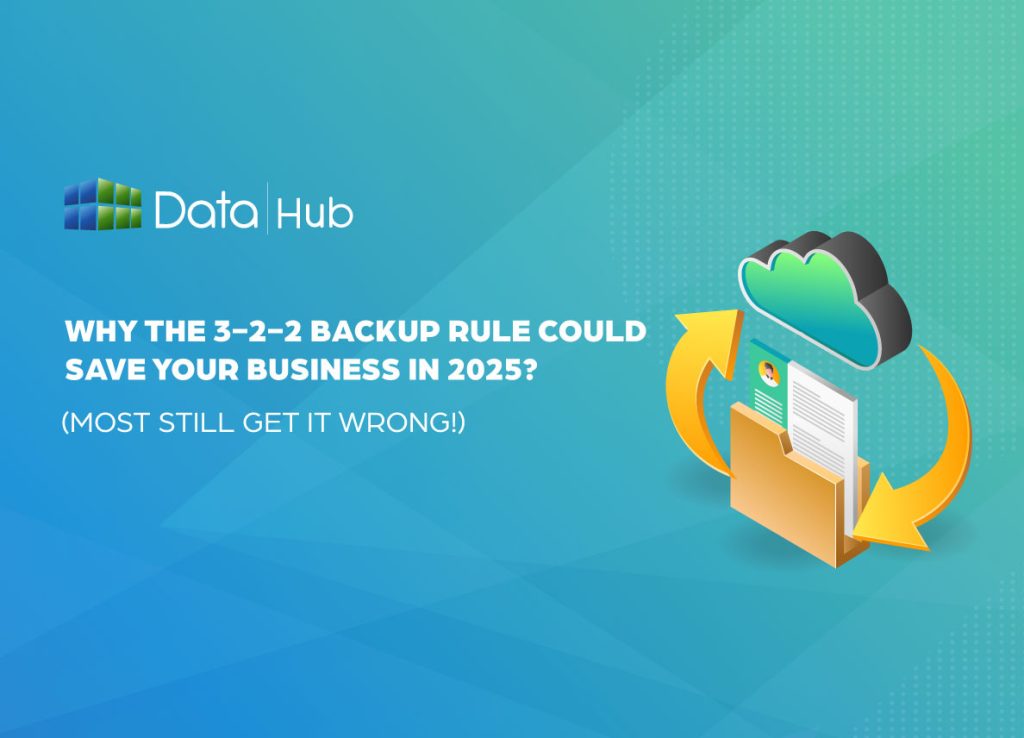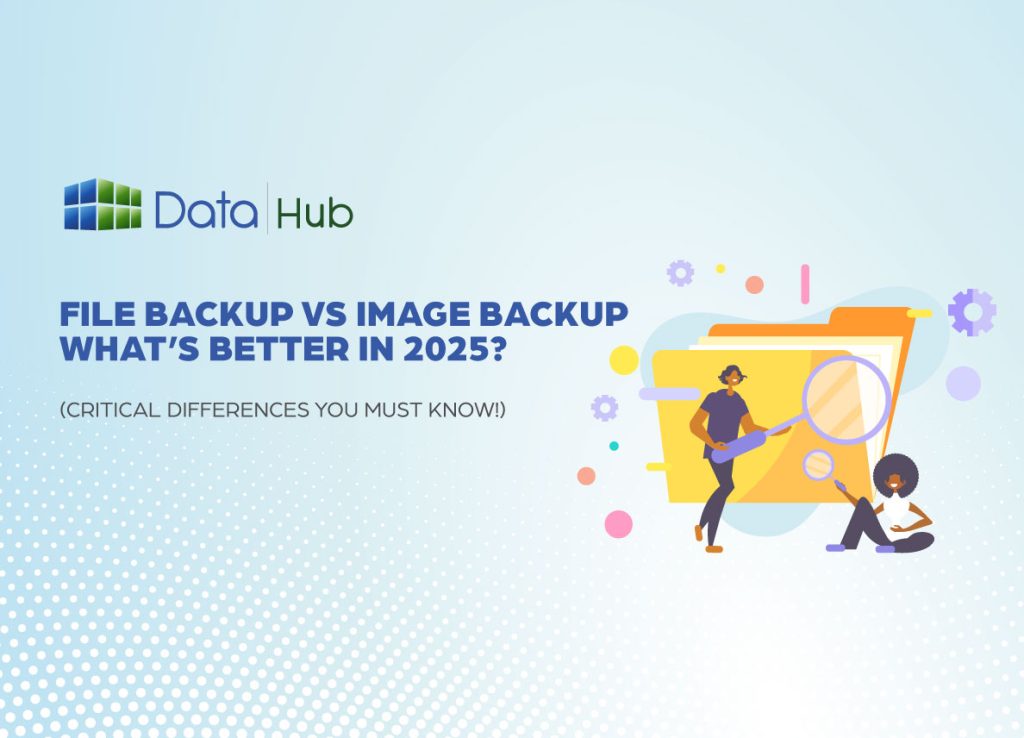Why Could the 3-2-2 Backup Rule Save Your Business in 2026? (Most Still Get It Wrong)

In 2026, the biggest threat to businesses, whether startups or large enterprises, is not competition. It’s data loss. Every day, businesses across Nepal and the world lose critical data to accidental deletions, ransomware attacks, hardware failures, or server crashes. Unfortunately, most businesses only realize the importance of backups after losing irreplaceable data Even a few minutes of downtime can cost a business lost sales, broken workflows, and damaged reputation losses no modern organization can afford.. That’s where the 3-2-2 Backup Rule comes in a smarter, modern approach that keeps your data protected under any circumstance. You will find out in this guide what the 3 2 2 rule is, why it is gaining ground as the global one in 2026, and how DataHub Nepal facilitates its adoption by businesses all over the country without much trouble. Why Data Backup Matters? Nepal’s digital ecosystem is rapidly expanding, not just in fintech and e-commerce, but also across IT firms, NGOs, and government sectors. This expansion leads to a continuous increase in reliance on digital information. Nevertheless, additional information is associated with increased risk. Ordinarily, business data loss in Nepal in 2026 is caused by: Nevertheless, with such threats, most Nepali companies use single cloud backup or simple hard-drive storage, assuming it is good enough. Unfortunately, that’s a major mistake. What Is a Data Backup? Data backup simply means creating copies of your important files and systems, so they can be restored if the originals are lost or damaged. But not all backups are created equally. The real difference lies in how many copies you keep, where you store them, and how easily you can recover them. That’s why IT experts and data protection professionals now recommend upgrading the old 3-2-1 rule to the more reliable 3-2-2 backup rule built for the hybrid, cloud-based business environments of 2026. What Is the 3-2-2 Backup Rule and Why It’s the Smarter Strategy? The 3-2-2 Backup Rule is a simple yet powerful framework designed to eliminate single points of failure. Here’s how it works: A. 3 Copies of Your Data One primary (live) copy and two backup copies. This ensures redundancy even if one backup fails, another exists. B. Different Storage Types Use different media, such as cloud storage and local servers, or hard drives and NAS devices. This prevents a single point of failure. C. 2 Offsite or Offline Backups Keep one copy offsite in a secure data center such as DataHub Nepal, and another completely offline like a disconnected external drive for maximum protection. This safeguards against both cyberattacks and local disasters. In short: Even if your office server crashes or a ransomware attack encrypts everything, your data remains safe in at least two other locations, one cloud-based and one offline. 3-2-2 vs. 3-2-1: Why Businesses Must Upgrade? While the classic 3-2-1 rule (3 copies, 2 types, 1 offsite) worked well in the past, evolving cyber threats and hybrid IT environments demand a stronger safeguard. Here’s why 3-2-2 wins in 2026: What Happens When Businesses Don’t Back Up Properly? Here’s what many organizations in Nepal experience when they skip proper backup strategies: A single data loss incident can cost lakhs in revenue along with lasting damage to reputation, compliance, and productivity. How Cloud and Hybrid Environments Changed Backup in 2026? In 2026, most Nepali businesses operate in hybrid environments combining on-premises infrastructure with public or private cloud systems. While cloud backup is convenient, relying on a single provider introduces new risks like vendor outages, security breaches, and sync errors. Why? That’s why DataHub Nepal’s hybrid cloud and data center solutions are trusted, giving you full control, physical security, and local support while still integrating with global cloud tools. Pros and Cons of Backup Methods (in Simple Points) 1. Local Backup (Hard Drives, NAS): Pros: Cons: 2. Cloud Backup: Pros: Cons: May be hacked if not configured properly Requires stable internet 3. Offline or Data Center Backup: Pros: Immune to online attacks Physically secure and managed Cons: Needs routine maintenance Slightly slower to restore Therefore 3-2-2 rule comes in by combining all three: balancing speed, safety, and reliability. Implementing the 3-2-2 Rule Step-by-Step Implementation The 3 2 2 rule can be used in your business in 2026 in this way: Determine vital information: databases, emails, financial systems, and documents. Formulate three copies, that is, one active copy and two backups. Use two types of storage, one on physical NAS and the other on the cloud. Have two off-site or offline backups, one at a DataHub Nepal data center, and another in an offline device. Automate your backups to minimize human error and ensure consistency. Test recovery regularly to ensure data can be restored when needed. Review and update your backup policies every quarter to stay aligned with new risks and technologies. Best Practices for Reliable Backup Common Mistakes Businesses Still Make Even in 2026, many businesses in Nepal continue to make the same data protection mistakes, often without realizing the risk until disaster strikes. Here are the most common ones: Avoiding these pitfalls starts with adopting a proven, modern framework like the 3-2-2 backup rule, which ensures your data is always protected, recoverable, and safe from both online and offline threats. Why Choose DataHub Nepal for Backup Service? DataHub Nepal is a reputable company specializing in data center and cloud services, which assists businesses of all types in preserving their most valuable asset: data. The differentiator of DataHub Nepal is as follows: Startups, IT companies, or government departments, DataHub Nepal offers them the stability and scalability they require to be completely at ease. Conclusion In 2026, data is more than just digital information; it’s the foundation of every decision, transaction, and customer relationship your business depends on. Yet, many organizations still underestimate the true cost of data loss until it’s too late. A single hardware failure, cyberattack, or accidental deletion can erase months, even years of hard work in seconds. Adopting the 3-2-2 Backup Rule isn’t just a smart choice, it’s essential for long-term
File Backup vs Image Backup: What’s Better in 2026?

In today’s digital era, data is among the most valuable assets, whether for businesses managing critical records, researchers handling projects, or individuals safeguarding personal documents. Data loss from hardware failures, ransomware attacks, or human errors can be catastrophic. As digital reliance and cloud adoption grow globally, establishing a robust data protection strategy is now essential for business continuity. For users with limited connectivity, hardware constraints, or minimal IT support, an automated backup system ensures continuous data availability and quick recovery from failures. That’s where DataHub Nepal comes in. As a trusted local cloud provider, DataHub delivers secure cloud and hybrid backup solutions, keeping your data safe, accessible anytime, anywhere, and easy to restore. If you’re unsure whether to choose file backup or image backup, this guide breaks down their core differences, benefits, and use cases, helping you make the right decision for data safety in 2026. Understanding the Basics: File Backup vs Image Backup Before diving into the comparison, let’s clarify what each backup method truly does. What is a File Backup? File backup involves saving selected files and folders such as documents, images, and databases, without replicating the entire operating system or application stack. Users can define what to back up, when to schedule it, and where to store it—whether on the cloud, an external drive, or a NAS device. What is Image Backup? Image backup (or system image backup) creates a complete replica of your entire system, including the operating system, configurations, applications, and user data. It works like a snapshot of your entire system at a specific point in time. In case of system failure, you can restore the entire environment exactly as it was before the disruption. Top Data Backup Trends Shaping Nepal in 2026 1. Rising Cyber Threats 2. Affordable SSD Storage 3. Cloud Adoption Growth 4. Hybrid Backup Strategies 5. Improved Internet Speeds Takeaway: Backup is no longer optional; it’s a critical element of digital safety for individuals and organizations in Nepal. Key Differences: File Backup vs Image Backup Not All Backups Are Equal: The Smartest Methods for 2026 The choice depends on your needs: speed, storage, and system recovery. File Backup is Best If: Image Backup is Best If: Businesses handling sensitive data can benefit from Cloud Backup for Businesses in Nepal when: Expert Recommendation: Hybrid Approach For most Nepali users, the best strategy in 2026 is a Hybrid Backup Strategy: combining the speed of file backups with the safety of image backups for total protection. Perform daily file backups and monthly image backups to balance speed, storage, and full system protection. This ensures speed, security, and comprehensive recovery. Step-by-Step Backup Implementation for Nepali Users Pro Tip: Combine cloud storage with local SSD backups for optimal redundancy and data security. Why Backups Fail? (And How to Avoid It) Many people think their data is safe until disaster strikes. Most backup failures happen because of these common Reasons: How to Avoid It: Are you Ready to Protect Your Data with DataHub Nepal? Data can be lost at any moment, and you do not need to wait before securing yourself. With DataHub Nepal, you will get secure file and image backup, quick system recovery, and 24/7 local support, all targeting Nepali customers in 2026. There is no need to lose any valuable files, assignments, or even business data. Take control today and ensure your digital life stays safe and accessible. Book a free consultation session with an expert and discover the most appropriate backup solution for your situation and get an individual consultation before it is too late. Conclusion Data loss is no longer a rare event, it’s a real and growing risk in 2026. Everything you’ve worked on can vanish in a single hard drive crash, malware attack, or accidental deletion. A single error can destroy all your information. This is why it is important to choose the correct backup strategy. Need to recover important papers fast? Use file backup. Need full system protection? Go with image backup. For complete peace of mind, adopt a hybrid backup strategy powered by DataHub Nepal. With advanced data centers, optimized recovery times, and expert technical support, modern cloud providers ensure your files and your future remain protected. Don’t wait until it’s too late. Protect your data today with DataHub Nepal, Nepal’s trusted name in secure cloud and image backup solutions. Start your backup now. FAQs

